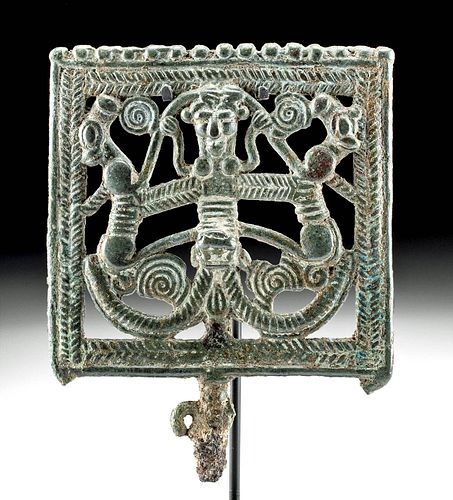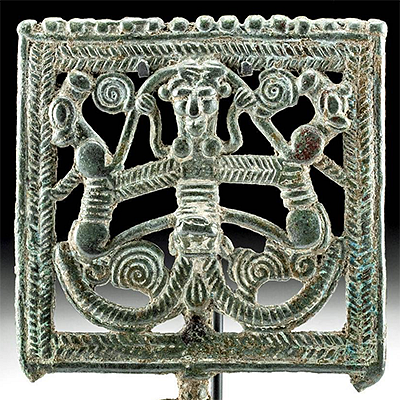Published Luristan Leaded Bronze Pin Head, ex Sotheby's
Lot 41
About Seller
Artemis Fine Arts
686 S Taylor Ave, Ste 106
Louisville, CO 80027
United States
Selling antiquities, ancient and ethnographic art online since 1993, Artemis Gallery specializes in Classical Antiquities (Egyptian, Greek, Roman, Near Eastern), Asian, Pre-Columbian, African / Tribal / Oceanographic art. Our extensive inventory includes pottery, stone, metal, wood, glass and textil...Read more
Categories
Estimate:
$6,000 - $9,000
Absentee vs Live bid
Two ways to bid:
- Leave a max absentee bid and the platform will bid on your behalf up to your maximum bid during the live auction.
- Bid live during the auction and your bids will be submitted real-time to the auctioneer.
Bid Increments
| Price | Bid Increment |
|---|---|
| $0 | $25 |
| $300 | $50 |
| $1,000 | $100 |
| $2,000 | $250 |
| $5,000 | $500 |
| $10,000 | $1,000 |
| $20,000 | $2,500 |
| $50,000 | $5,000 |
| $100,000 | $10,000 |
| $200,000 | $20,000 |
About Auction
By Artemis Fine Arts
Nov 5, 2020
Set Reminder
2020-11-05 10:00:00
2020-11-05 10:00:00
America/New_York
Bidsquare
Bidsquare : Ancient & Ethnographic From Around the World
https://www.bidsquare.com/auctions/artemis-gallery/ancient-ethnographic-from-around-the-world-5916
Ancient art from Egypt, Greece, Italy and the Near East, as well as Asian, Pre-Columbian, Native American, African / Tribal / Oceanic, Spanish Colonial, Russian Icons, Fine art, much more! All categories, all price ranges... all legally acquired and guaranteed to be as described or your money back. Artemis Fine Arts info@artemisgallery.com
Ancient art from Egypt, Greece, Italy and the Near East, as well as Asian, Pre-Columbian, Native American, African / Tribal / Oceanic, Spanish Colonial, Russian Icons, Fine art, much more! All categories, all price ranges... all legally acquired and guaranteed to be as described or your money back. Artemis Fine Arts info@artemisgallery.com
- Lot Description
Ancient Near East, northwestern Iran, Luristan, ca. 8th to 7th century BCE. A spectacular leaded bronze square openwork in the style of "master of animals;" a highly stylized anthropomorphic figure flanked by two beasts. The man stands in the center with arms raised, grasping the front legs of the two animals in profile, perhaps, wild lions, to keep them at bay. Spirals and curving bands of open work decorate and support these figures. The scene is framed by a border of incised chevron shapes. And the top is edged with a row of round ridges. The bottom has the centrally located shank for the pin that this final attached to. This intricate piece perhaps pinned the cloak or clothing of a wealthy or elite during ceremony, however the full symbolism of the stunning motif is unknown. Size: 3.625" W x 4.6" H (9.2 cm x 11.7 cm); 5.55" H (14.1 cm) on included custom stand.
Luristan is a province in central western Iran. It comprises an area of plains surrounded by the high ranges of the Zagros mountains and has supported a population of nomadic peoples and mountain communities for thousands of years. Bronze working in this region is known from as early as 3000 BC, but it is during the ninth to seventh centuries, from which period the present piece dates, that it reached the pinnacle of its craftsmanship in this medium. Luristan was set apart from its neighboring regions by the prolific appearance of elaborately decorated cast ornaments, including standard finials, horse trappings and pins, usually incorporating stylized animal and anthropomorphic motifs. The bronze workers of Luristan excelled particularly in producing decoration for horses, at a time when cavalry was eclipsing chariotry as the main mobile force in many Near Eastern armies. The relatively sudden emergence of this new artistic style is generally considered to have been initiated by a group of newcomers to the area, probably a nomadic people; their dependency on movement for their way of life meant that many forms of material wealth presented a conceptual and physical impediment. For this reason, expressions of status, conveyed by artistic virtuosity, are contained in portable objects of personal adornment or military utility.
Published: J. Eisenberg, Art of the Ancient World, volume V (1988), no. 87. On loan to Picker Art Gallery, Colgate University; Fitchburg Art Museum - 1990 to 2016.
Provenance: E.B. collection, Orion, Michigan, USA acquired from Royal-Athena in March 1989; ex-Sotheby’s, London July 1987 sale Lot #109. Published: J. Eisenberg, Art of the Ancient World, volume V (1988), no. 87. On loan to Picker Art Gallery, Colgate University; Fitchburg Art Museum - 1990 to 2016.
All items legal to buy/sell under U.S. Statute covering cultural patrimony Code 2600, CHAPTER 14, and are guaranteed to be as described or your money back.
A Certificate of Authenticity will accompany all winning bids.
We ship worldwide and handle all shipping in-house for your convenience.
#156862Originally on iron shank. Loss to original iron pin on bottom and areas of both spiraling discs on lower body as shown. Slight bending to overall form, with encrustations within recessed areas, minor softening to some finer details, and nicks to peripheries and verso. Great patina and remains of detailing throughout.Condition
- Shipping Info
-
All shipping is handled in-house for your convenience. Your invoice from Artemis Gallery will include shipping calculation instructions. If in doubt, please inquire BEFORE bidding for estimated shipping costs for individual items.
-
- Buyer's Premium



 EUR
EUR CAD
CAD AUD
AUD GBP
GBP MXN
MXN HKD
HKD CNY
CNY MYR
MYR SEK
SEK SGD
SGD CHF
CHF THB
THB














